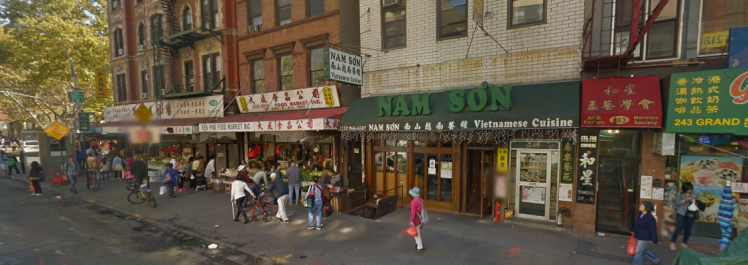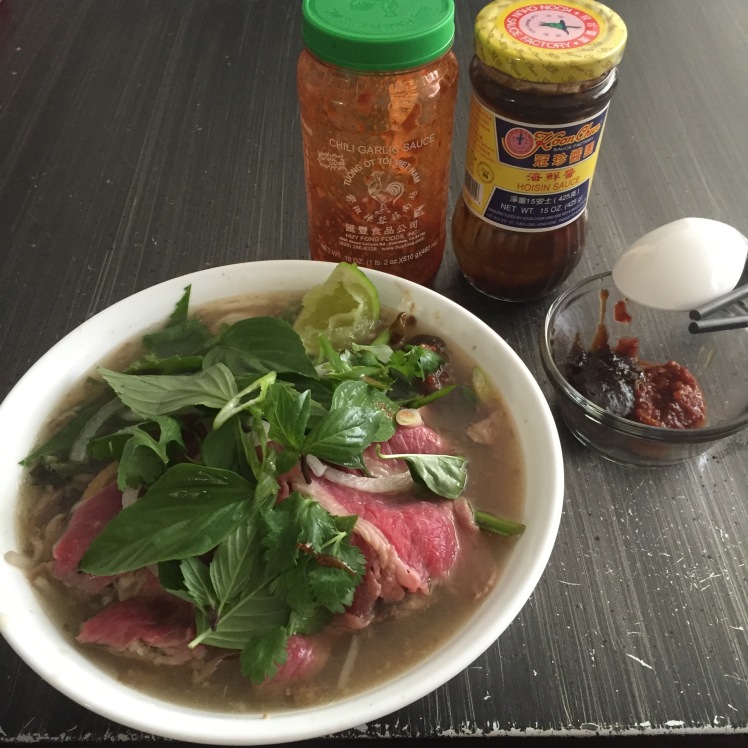So I’ll typically post a semi artsy-fartsy (i.e. Instagram filtered) photo of the Pho Bò recipe throughout the process. I’ve received a few requests for the recipe so I decided to blog about it. The process is time consuming and there are a lot of details that I’m super Type-A about and that’s mostly because my mom’s pickiness has trickled down. For example, how to prep the bean sprouts. We will get to that later. I’ll also give some locations that you can find some of the Vietnamese herbs and what not, if you’re local to LA or NYC. Those are the main cities I’ve lived in so I know of specific grocery stores that carry the brands that my mom and I are partial to using.
This recipe makes about 8 bowls worth of pho depending on how much broth you use per bowl. You can shorten the simmering time so the broth can be done in 3 1/2 hours but I always cook it for about 6 hours.
Ingredients
- Seasoning Stuff & Herbs
- 3 pieces of ginger, 2 inches square
- 2 ½ large yellow onions
- 3 scallions
- 1/3 bundle of cilantro
- 1 lb. mungbean sprouts
- bundle thai basil (aka holy basil)
- package of Ngò Gai (saw-leaf/sawtooth herb)
- thai bird chili peppers
- 4 limes, cut into 4
- 1 tablespoon sea salt
- 3 oz. of rock sugar or 3 tablespoons of sugar
- 2 cadamom pods or 1/3 teaspoon ground cardamom
- 8 anise stars
- 6 whole cloves
- 1 – 5 inch cinnamon stick
- 1 tablespoon coriander seeds
- 1 tablespoon fennel seeds
- Sauce Stuff & noodles
- Bánh Phở Noodles (Large size)
- Huy Fong Sriracha (green top/rooster sriracha)
- Koon Chun Hoisin
- Garlic Chili Sauce
- Three Crabs brand nước mắm (fish sauce)
- Meats
- 1 package of Bò Viên (Vietnamese meatballs)
- 2 lbs. beef bone marrow
- 3 lbs. oxtail bones
- 2 lbs. beef brisket, cut in half
- 1 lb. lean cut of beef (I usually use flank steak or tri tip)
- 1 lb. beef liver
- Utensils
- 8 quart stock pot or 2 large pots
- metal spice ball/tea infuser or cheese cloth and butcher’s string
- cast iron pan or baking pan that can withstand broiling
- Colander with a long handle
Where to find some of these items
I know the ingredient’s list is extensive and there are a lot of items that will have you scratching your head.
For the meats, if you’re living in LA, I typically hit up Zion Market in Koreatown, Bangkok Market in Koreatown/East Hollywood, and if you’re looking for a higher grade of cuts, Marconda’s and Huntington Meats (at the Grove) usually have what I’m looking for. Lately the Studio City Ralph’s has some of the items I’ll need. Recently I browsed and saw beef liver, oxtail bones (once in a while), and beef marrow.
Zion Market is a Korean market so items that are specifically Vietnamese (ex: Bò Viên, Ngò Gai and Thai basil) you’ll need to go to a Thai/Vietnamese/South Pacific Asian grocery store.
If you live in NYC, look up the address for 243 Grand St. This main street in Chinatown typically has all that I need. Right on the corner of Grand and Chrystie is a butcher shop that I was able to get all the meats I needed except for the Bò Viên. You just have to go right next door for that. Ken Hing Food Market will also carry the thai/holy basil, Ngò Gai (saw tooth herbs), Bánh Phở, Mung bean sprouts and Vietnamese sauces.


Pictured here is what Bò Viên looks like. I use the brand and kind pictured, that has tendon added to it. There are different variations of pho that have tendon and tripe added. I love ordering it when I’m at a Pho spot, but cleaning and cooking those items is difficult, so I stick to these.
Directions
First thing is to put your flank/trip tip/lean meat in the freezer. I’ll get to why later. Just do it. Then, you’ll need a 8 quart stock pot as it will also contain all the bones and meats as it stews. I cheat this by using 2 large pots and split the liquid, bones, and create 2 seasoning bags. Fill stock pot (or pots, equally) with 6 quarts of water total. Bring to a boil and add the oxtail bones, bone marrow, and beef brisket. When it comes to rolling boil, add the liver. After 5 minutes, remove everything, drain the water and rinse the meats. Wash out the pot. There’s going to be a grime/foam. This initial boil is to get rid of the impurities that will cloud your broth. You’d have to work more at skimming the foam/grime later if you don’t do this. Also, dunk the liver in cold water to prevent it from continuing to cook and get too tough.
Refill the clean stock pot with 7 quarts of water, brisket, bone marrow, and oxtail bones and bring to a boil.
As you wait for it to get back to boiling, roughly peel the skin off the ginger and cut so you have about 3 chunks. Peel 2 of the yellow onions but try to keep the onion in tact. Brush a little cooking oil onto the ginger and onion and place on your cast iron. Turn your oven to broil and when it’s hot, pop the pan in the broiler. It should only take a few minutes to char so keep an eye on it or you’ll get a kitchen full of smoke.
Also, toast your anise stars, cinnamon stick and whole cloves in either a toaster oven or for a minute in the oven while the onion and ginger is charring.

 Create your seasoning bag with the cinnamon stick broken into 2 or 3 pieces, fennel seeds, coriander seeds, toasted anise and whole cloves, and 2 cardamom pods. If you can’t find the pods you can use the ground up substitute but you’ll get a more potent cardamom flavor. I use a metal tea infuser/spice ball so it hooks to the lip of your pot and won’t risk tearing. If you don’t have this you can use a cheese cloth. Double layer it and tie with butcher string. Keep an eye on it as the seeds and whatnot will expand and might break open.
Create your seasoning bag with the cinnamon stick broken into 2 or 3 pieces, fennel seeds, coriander seeds, toasted anise and whole cloves, and 2 cardamom pods. If you can’t find the pods you can use the ground up substitute but you’ll get a more potent cardamom flavor. I use a metal tea infuser/spice ball so it hooks to the lip of your pot and won’t risk tearing. If you don’t have this you can use a cheese cloth. Double layer it and tie with butcher string. Keep an eye on it as the seeds and whatnot will expand and might break open.
Once the stock pot has come back to a boil, bring it down to a simmer. If there is any foam/grime skim that off. Add the charred onions, ginger, nước mắm, and sugar. After 30 minutes remove 1 piece of the beef brisket. Leave the other chunk in to continue to flavor the broth. The piece removed should be submerses in cold water with some ice cubes to stop the cooking process. Let the broth simmer for another 2 hours.
Most recipes tell you to skim the fat off but doing so often causes you to throw out a good amount of broth. I have an odd process to skim the fat. Once you have allowed the broth to simmer for 2 hours enough fat from the meat and bones has seeped out. Ladle off the top of the stock pot and pour into 2 small bowls. I use a baking dish that can hold both bowls. Once placed in add ice cubes to the pan and fill the pan with cold water. Place this contraption in your freezer. After about 15 minutes check on it. The fat will rise to the top as a solid. You can scrape this off and throw it away. What is underneath can be added back to the stock pot. If you want a leaner broth you can do this a second time. You want to keep some of the fat in the stock for the flavor so I wouldn’t recommend this more than 2 times.
Once the stock comes back to a simmer, add the seasoning bag. After 30 minutes add sea salt and stir. I let this simmer for another 2 hours while I prep all the accoutrements.
 Soak the Bánh Phở in cold water for about 30 minutes, drain and set aside. This is from the Bangkok Market in LA. I prefer the large cut noodles but all the had this day was medium, which works fine. One pack usually is enough for 4-5 bowls depending on how noodly you want it. You can always refrigerate after soaking so you can portion out leftovers
Soak the Bánh Phở in cold water for about 30 minutes, drain and set aside. This is from the Bangkok Market in LA. I prefer the large cut noodles but all the had this day was medium, which works fine. One pack usually is enough for 4-5 bowls depending on how noodly you want it. You can always refrigerate after soaking so you can portion out leftovers

Prep the beansprouts, thai basil, cilantro, scallions, Ngò Gai (saw tooth herb), lime, and chilies. Typically these items are put on a communal plate in the center of the table. My mother always preferred that they were done a certain way:
Mungbean sprouts and soybean sprouts are different in flavor and texture. Soybean sprouts have a harder “bean” and are thicker. Mungbean sprouts are more pliable. My mom was (and STILL is) super picky about rinsing them and cleaning the tails off. It’s tedious but they’ll keep longer if you snap off the tails and remove any pieces that are soggy or browned.
Whether you do a communal plate or add everything to each bowl as you ladle the soup out, I’d recommend removing the thai basil leaves from the stem, rinsing and drying. Easier to add the amount you want and also to get rid of the wilted or browned leaves. I also do this with the cilantro. You can chop with the stems but I prefer the leaves.
I julienne cut into thin rings the scallions, thinly slice the yellow onion as pictured above. The thai bird chili peppers can be sliced and put in a small sauce dish so everyone can add as much as they like. Warning: they are small but pack a punch!
 For the Ngò Gai (saw tooth herb), I cut the bottom, tougher portion off and slice into 3 sections. The saw tooth herb is fairly long and has a great cilantro (but stronger) flavor. It can be difficult to track down but worth it. Definitely helps make the dish special.
For the Ngò Gai (saw tooth herb), I cut the bottom, tougher portion off and slice into 3 sections. The saw tooth herb is fairly long and has a great cilantro (but stronger) flavor. It can be difficult to track down but worth it. Definitely helps make the dish special.
Before cutting your limes I’d recommend leaving them out at room temperature, if you’re the type that refrigerates them. You’ll get more juice when they aren’t cold. Cut into 4’s so they’re large enough of a wedge to squeeze over the soup.
Remember the liver and brisket dunked in cold water? Pull those out and thinly slice. Also, the flank steak (or tri-tip, whatever cut you picked) that’s in the freezer, thinly slice against the grain. As thinly as humanly possible. The Bò Viên (meatballs) you can cut in half or in 3’s. I prefer 3’s so it’s easier to grab with your chopsticks and nibble. Set these meats aside because you’re finally at the plating up point!
 However many people you’re serving get out wide mouthed soup bowls and portion out the amount of noodles everyone wants. Remember they will expand and there’s a lot going into the final dish so don’t add too much.
However many people you’re serving get out wide mouthed soup bowls and portion out the amount of noodles everyone wants. Remember they will expand and there’s a lot going into the final dish so don’t add too much.
If you cheated like I usually do with using 2 pots, you can likely combine them at this point. I lose about 2 quarts of liquid throughout the whole process. Bring the stock pot to boiling and take a colander that has a long enough handle so you can place the strainer into the soup, but easily removable. Add each bowl’s noodles to the colander. let sit for about 2 minutes and check the firmness. If it’s still a little tough leave in for another minute.
Use the colander to bring the meatballs, brisket and liver back to temperature in the soup and add to the bowl with noodles. Place 3-4 slices of flank steak (or whatever cut you chose) on top. Add desired amount of beansprouts, green onions, cilantro, saw tooth herbs, and the raw yellow onion slices.
Ladle an oxtail and broth to each bowl and make sure to pour the soup over the flank steak. As it sits while you’re eating it will cook. Have the limes and thai chili slices on a plate for everyone to grab.

I leave all the sauce containers (except the fish sauce) on the table so people can add what they like. Pictured above are the brands that I’m used to using. The Three Crab fish sauce has a great flavor and packs a punch. There are other more commercial brands of hoisin sauce in squeeze bottles. I like this one that you’ll need to spoon out. Darker color and thicker consistency. I recommend leaving a little saucer for each person. I like to add hoisin and chili garlic sauce to my pho AND also on the side for dipping the meats. Squeeze a lime wedge over it all, plop it in and dig in! Hope you enjoy the fruits of your labor.

